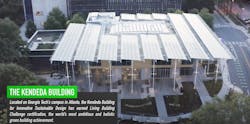Georgia Tech facility receives prestigious green building recognition
The Georgia Institute of Technology has announced that The Kendeda Building for Innovative Sustainable Design on its Atlanta campus has received Living Building Challenge certification, the world’s most ambitious and holistic green building achievement.
The university says the certification from the International Living Future Institute independently verifies that The Kendeda Building is among the greenest in the world.
The Living Building Challenge (version 3.1) requires a 12-month performance period, during which the project must prove it is net-positive for energy and water.
This means it must generate more energy from onsite renewable sources than it uses, and also collect and treat more rainwater onsite than it uses for all purposes, including for drinking.
Meeting all seven Petals in the Living Building Challenge — Place, Water, Energy, Health + Happiness, Materials, Equity, and Beauty — The Kendeda Building is the first Living Building Challenge-certified building of its scale in the southeastern United Stats., where a warm humid climate poses many challenges.
Over the performance period, the building generated 225% of the energy needed to power all of its electrical systems from solar panels on its roof. It also collected, treated, and infiltrated 15 times the amount of water needed for building functions.
“Students passing through The Kendeda Building today will be the engineers, architects, scientists, product designers, urban planners, and policymakers of tomorrow,” says Diana Blank, the founder of The Kendeda Fund, whose $30 million grant to Georgia Tech made the building possible. “By raising the bar for building performance, we are encouraging Georgia Tech to keep reaching higher.”
To ensure Living Building Challenge certification by fulfilling the requirements in the Petals performance categories, the Kendeda Building’s performance metrics incorporated the following:
- The energy-efficient electrical and mechanical equipment and tight building envelope, with a 330-kilowatt photovoltaic canopy supplies 225% of the building’s energy needs on an annual basis.
- The photovoltaic canopy shades the building and captures rainwater. The water is stored in a 50,000-gallon cistern in the basement before being treated and used for all purposes, including drinking.
- The building is composed of materials screened to ensure the absence of hazardous “Red List” chemicals, such as bisphenol A (BPA), halogenated flame retardants, phthalates, and formaldehyde. Chemicals on the Red List have been shown to harm human and environmental health, even though they are common in most buildings.
- Wood from sustainably managed forests, salvaged materials, and other sourcing strategies significantly reduce the building’s embodied carbon emissions.
- By eliminating 99% of its construction waste and incorporating reclaimed, locally sourced materials such as reclaimed wood for the structural decking and salvaged slate tile in the restrooms, the project diverted more waste from the landfill than it sent to the landfill.
- Composting toilets nearly eliminate potable water use for sewage conveyance and allow for human waste to be turned into fertilizer for use offsite.
- The building allows for universal access. Its central feature is an accessible ramp connecting the terraced main floor so that everyone has a similar experience throughout the building.
- The design and construction team went above and beyond the Living Building Challenge Equity Petal by promoting an equitable and inclusive sense of community. To build the ceiling panels and floor systems, for example, the general contractor partnered with Georgia Works!, a nonprofit helping chronically homeless men become self-sufficient.
At $544 per gross square foot, The Kendeda Building is 13% more expensive than a comparable building at Georgia Tech. However, in reality, there are few comparable buildings of this type that include the infrastructure for net-positive energy and water in the construction cost.
The architects are The Miller Hull Partnership and Lord Aeck Sargent and the general contractor is Skanska.
